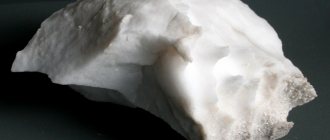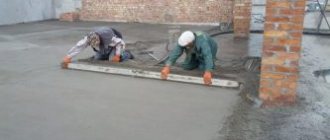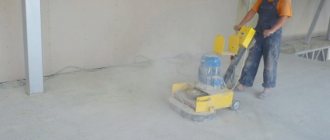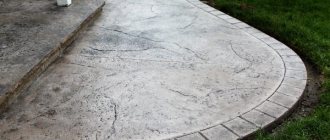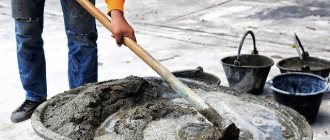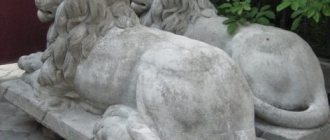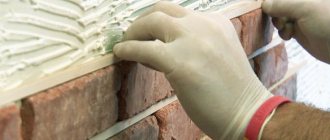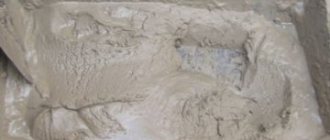I am often asked what the proportions of gypsum and water should be to make artificial stone? I'm already tired of answering this question, so I decided to write this article.
The fact is that plaster is all different and each requires a different amount of water . For example, I work with MAGMA g-6 B3 (molding) gypsum - this is finely ground gypsum. It needs more water than the same one, but B2 grinding. Without adding a plasticizer, I do this: 800 grams of water and 1 kg of gypsum. I knead for about 15-20 seconds, if longer, the solution begins to harden quickly. The stone turns out to be of weak strength, but I worked this way for a long time and basically had no problems. Preferably stronger, of course.
You can do it 1 to 1, but then the stone will be very fragile. A friend of mine works this way and says that there hasn’t been a single complaint yet. I also tried this, just for fun... in general, this “stone” is cut with a stationery knife... I definitely wouldn’t sell it.
With the addition of the plasticizer Friplast, the proportions are as follows: 600 grams of water + 1 kg of gypsum + 30 grams of plasticizer. The stone turns out to be durable, just what you need. To save gypsum and plasticizer, I slightly increase the amount of water, and reduce the amount of gypsum and freeplast: 700 g. water + 1 kg of gypsum and 15 grams of free plastic.
As you can see, the amount of water in each option is different and the strength of the stone will also be different. Where there is less water, the stone is stronger.
Recently I bought Hercules g-5 gypsum, medium grind, used it with SVV-500, made the following batch: 500 g. water + 1 kg of gypsum + 40 grams of SBB. The mixture turned out well, the stone is very strong. But this doesn’t work with magma, I do this with it: 550 water + 40 grams of dry solids + 1 kg of gypsum.
I also worked with gypsum G16, adding 500 grams of water per kilogram. With the addition of a plasticizer, I reduced the water to 300 grams, and accordingly made 300 grams more gypsum. The result was simply a very, very strong stone; in principle, there was no need to make one like this, it was just an experiment. In general, you don’t need to add any additives to gypsum G16; the products have good strength.
I think it has become clear to you that there is no single recipe , you need to test and see the result. If you still can’t decide how to dilute the plaster, then do tests with one kilogram of gypsum. Take 600 grams of water and add 1 kg of gypsum to it, stir with a mixer for about 15-20 seconds, this time is enough to stir all the lumps. Pour the mixture into the mold if:
- The mixture has thickened and you haven’t had time to properly level it, then in the next batch, increase the water by 100 grams. And so on until you get a good mixture, but do not forget that a large volume of water in the solution reduces strength.
- After leveling the mixture according to shape, there is water on the surface of the tiles, then you need to reduce the amount of water.
By the way, here’s a question from our community: how much will the volume of gypsum increase when using a plasticizer.
We are waiting at Barkhotskaya, 1a
"Orso Bruno" is a finishing materials store with direct distribution of Mapei, Pergo, Ursa, Forbo Eurocol, Poleo. We also train clients at seminars and provide consultations at work stages. The finishing materials sold are certified according to European quality standards. "Orso Bruno" - The support of your renovation.
Smooth walls are the key to quality repairs. And one of the simple and reliable ways to level and decorate walls is to plaster them. In this article we will examine in detail all the issues related to gypsum plaster: what it is needed for, what its features and technical characteristics are, pros and cons, and areas of application. We will also clearly show how to work with this material.
Use in damp rooms and outdoors
As we have already mentioned, gypsum plaster is capable of absorbing moisture, so its use in wet rooms and especially for facade finishing is not advisable.
If it is necessary to make the gypsum surface moisture-resistant (for example, when preparing to lay tiles in the bathroom), it is coated with a deep penetration primer based on acrylic. Concrete contact soil is ideal for tiles.
Polymer waterproofing mastic, for example, Plitonit Gidroelast, also has good moisture-proof properties. It is applied on top of a thoroughly dried layer of plaster using a brush or roller in several layers. Each of them must be applied after the previous one has dried. Gluing of tiles is allowed only one day after application. It is recommended to fill the outlets of pipes and corners of various structures with the same mastic.
Finishing of aligned walls
After applying a layer of plaster, it is necessary to determine how further finishing will take place:
As you can see, gypsum mixtures are extremely in demand in finishing and repair work and are used everywhere.
We hope that this article was useful to you and that you found the information you were interested in. Please leave your questions and comments in the comments below.
Form and through sieve No. 0355 (400 holes/cm2) for casting burls and models. When mixing gypsum with water, gypsum particles, suspended in water, become covered with an aqueous film. 1-5 minutes after mixing, hydration of the gypsum begins, the solution acquires a thick-flowing consistency and becomes suitable for casting. The procedure for preparing a gypsum solution is as follows: water heated to a temperature of 35-40 ° C is poured into a mixer, then molding gypsum is poured into it and after 0.5-1 minutes the mixture is stirred for 2-3 minutes. The prepared gypsum solution is immediately poured into matrix molds or trays.
The water-gypsum ratio (gypsum: water) largely determines the quality of gypsum forms. This is explained by the fact that for complete hydration of gypsum, 18.6% (by weight) of water is required, the rest of the water - more than 80% - remains in a free state, determining the porosity of the dried form, its structure and strength. The strength of gypsum castings is inversely proportional to the consistency of the gypsum solution. With an increase in the water-gypsum ratio, the size of the crystals of gypsum dihydrate increases; with a decrease, not only the porosity decreases, but also the average pore size.
When making molds, we are guided by the following optimal ratios of gypsum: water, such as 1:1 - for casting molds; 1.43; 1 - for plastic molding forms; 1.6:1 - for making burls and models; 1.25:1 for molds intended for casting and plastic molding. In practice, the following ratios are most often used: 56:44 - for molds used on spindle machines and for casting thin-walled products; 60:40 - for molds used for molding products on semi-automatic and automatic machines; 50:50 - for molds used for casting regular products and molding capsules; 67:33 - for preparing burls and models.
Vacuuming the gypsum solution for 1.5-2 minutes at a vacuum depth of 0.8-0.9 MPa extends the setting time by 15-20% and increases the mechanical strength. casting strength by 18-20%, improves the condition of the mold surface and increases mold turnover by 20-25%. The evacuated gypsum solution has increased fluidity and better fills all the irregularities and joints of the burl. Vacuuming helps reduce the porosity of molds by 10-12% and changes the nature of the pores. The structure of the mold is more uniform (Fig. 34) and does not have closed air inclusions, which reduce the strength of the mold and do not participate in the capillary suction of moisture. The expansion coefficient of the evacuated gypsum solution decreases.
The quality and efficiency of gypsum mortar during its preparation are increased by using mechanized and automated installations. In Germany, for example, Roko-Vakumat installations of ten standard sizes are used with a capacity from 100 to 1600 l/h.
Mixing of gypsum with water is carried out simultaneously with evacuation of the solution in special tanks. The dosing of gypsum and water, the depth and duration of vacuuming are automated.
Unloading of vacuum tanks and supply of gypsum solution to the place of casting molds at a distance of up to 150 m are carried out pneumatically. The duration of loading, preparing the solution, unloading and cleaning is 2-3 minutes, depending on the capacity of the tank (100-1600 l).
Rice. 34. Structure of a mold made from non-evacuated (a) and evacuated (b) gypsum mortar
Rice. 35. Influence of manufacturing conditions of gypsum molds on their strength 1 - water-gypsum ratio; 2 — mixing duration; 3 — degree of grinding
Strength, water absorption, hardness and other properties of molds largely depend on the degree of grinding of gypsum, the mode of mixing gypsum with water, the water-gypsum ratio, as well as the purity of the raw materials (Fig. 35). Heating water to a temperature of 35-40 ° C and adding 0.3-0.5% gypsum dihydrate helps to increase the strength of the molds. The length of time the gypsum solution remains in the ladle before pouring the molds should not exceed 2-3 minutes.
Instructions for preparing solutions for casting decorative stone
Gypsum is the only binder in construction that expands and heats up as it hardens, while at the same time being subject to warping, particularly in thick and long products. When making stucco, the expansion of gypsum is a positive property, because... at the same time, it penetrates into the smallest reliefs of the form (when casting parts). To reduce warping, gypsum is prepared with lime water (Lime water is prepared by mixing 1 kg of lime paste with 6 - 8 kg of water).
Gypsum mortar
The solution is prepared as follows: first, pour the required amount of water into the container, then add gypsum and quickly mix. To fill the molds, use a liquid solution (take 1.5 kg of gypsum per 1 liter of water); for stretching, use a medium or thick solution (take 1.5-2 kg of gypsum per 1 liter of water). It is better to mix a large volume with an electric mixer. It is better to mix a small amount with a spatula or a regular tablespoon; if the solution is liquid, use a paint brush. Then the solution will quickly turn out homogeneous without lumps. The brush should be rinsed immediately in water. It is better to use a container made of polyethylene or plastic. After the plaster has set, they are easy to clean, slightly deforming the container. In this case, the remnants of the set plaster crumble and come off on their own.
Plaster should be prepared very quickly and used immediately. If the gypsum dough (gypsum solution) that is beginning to harden is mixed with water again or simply stirred for a long time, the gypsum rejuvenates and stops hardening or setting. This solution can no longer be used.
To slow down the setting time of gypsum, retarders are used. A good retarder is a weak adhesive solution, which also gives increased strength to gypsum products. To prepare glue water, you can use CMC wallpaper glue (it is also found in stores, not to be confused with regular wallpaper glue) or wood glue. To prepare the adhesive solution, you must do the following: 1 part by weight of dry animal glue is soaked in 5 parts by weight of water for 15-16 hours or more. After the glue has completely dissolved, add 1 weight part of lime paste and boil the mixture in a water bath for 5-6 hours, stirring it occasionally. Before use, the resulting concentrate is diluted with water, and gypsum is diluted with the resulting adhesive water. In terms of its effectiveness, such water is 2-3 times higher than water prepared with a regular adhesive solution.
To reduce warping of gypsum and slow down its setting, borax is also used, which is taken at 0.5% by weight of the total amount of water on which the gypsum is mixed. After drying, immerse the gypsum product in a solution of copper sulfate (dense blue color), after repeated drying (this will take a long time!) the strength will increase significantly.
To lighten the mass of gypsum products, they are prepared from gypsum mixed with sawdust, which slows down the setting of the gypsum. Products can be made by adding coarse sand to gypsum or crushed stone screening (fractions 3-5 mm).
It is necessary to dry gypsum products in a warm room with a temperature not lower than 16°C, but in no case in a draft, which contributes to warping of the cast products.
Lime water also slows down the setting of gypsum, in addition, it increases its strength and prevents warping of products. In the production of gypsum products, high-quality slaked lime is necessarily used.
Lime is mandatory in the production of gypsum artificial decorative stone and other various gypsum products and is one of the most important components in the production of gypsum products.
In the production of gypsum mortars, lime paste, as well as slaked lime fluff, can be used to make gypsum products, but lime paste gives the best effect to the quality of the gypsum mortar. The quality of products, strength, drying time and many other quality indicators of finished gypsum products greatly depend on the quality of slaked lime in the composition of gypsum solutions. Lime significantly affects the quality of gypsum products; even if the stone is placed in a damp or damp room, it does not absorb moisture and has significant strength.
When making artificial stone from gypsum using painting, it is necessary to take into account that if the composition contains lime, then the rate of pigments and dyes should be slightly increased, because the lime that is in the composition of gypsum can partially discolor the pigments, dyes and tinting pastes used for coloring of gypsum products. An increase is necessary by 15-20%, while discoloration occurs only in the first days after manufacturing the artificial stone and painting, and subsequently the dried artificial stone no longer loses color.
There is another simple way to prepare plaster so that the solution does not set quickly, and there is more time to work with it. You need to pour plaster into a container with water, but do not mix it, but let it soak in water. This solution can be used a little longer. If you need to speed up the setting process of gypsum, you can add 1-4 g of table salt per 1 liter of water to the water, and/or dilute the gypsum in hot water.
The setting of gypsum is significantly accelerated when it is mixed with a reduced amount of water compared to that required for dough of normal thickness, and vice versa. But this requires additional vibration of the filled molds to distribute the thick solution throughout the entire mold and increase degassing.
Increasing the temperature of the gypsum dough to 40-46 ° C helps to accelerate its setting, and above this limit, on the contrary, slows it down.
To change the properties of stone (strength, frost resistance, etc.) various additives are used, the most popular of which is a plasticizer. A plasticizer is an additive that allows you to increase the fluidity and plasticity of the mixture while reducing the water-cement ratio. This increases the final strength and density of the hardened mortar. The plasticizer is sold in two forms - liquid and powder. Both need to be diluted in water for ease of use.
The weight of the additives used, including dyes and plasticizers, is determined as a percentage of the solution. On average, the weight is 1-2% of the total weight of the solution, unless otherwise indicated in the instructions for the substance.
Cement-lime mortar
It is prepared in the same way as regular one, but instead of water, liquidly diluted lime is used. Cement-lime mortar is quite strong and plastic. To produce durable lime mortar grades from M400 – M500 cements, use the following proportions of cement/lime/sand/crushed stone of fraction 3-5:
white cement M400 – 1/0.1/2.5/2.5
gray cement M500 – 1/0.3/2.5/2.5
This material is very plastic, can be applied to almost all types of surfaces, hardens quickly and is easy to process. It is used in a variety of industries: as a fertilizer, components of pulp and paper production, ingredients for the production of paints and enamels. And, of course, the burnt powder is used for casting internal elements of building decor, as a binding material in construction.
There are special types of construction grades. High-strength mixtures and gypsum-cement (pozzolanic) binders are produced. Working with plaster is not very difficult. As it hardens, it forms a stone-like mass that is very convenient for processing. Therefore, it is very widely used for the production of all kinds of crafts. Its obvious advantage here is the high fluidity of the solution, which is very convenient for casting products.
The fine-porous structure makes gypsum an indispensable material for creating all kinds of injection molds, also with the addition of high-temperature components.
The disadvantages include its low strength and hygroscopicity, so the use of such materials in rooms with high humidity is undesirable. If necessary, moisture protective coatings should be applied. In this case, you need to consider how to work with plaster correctly. The porous structure facilitates the absorption of the coating applied directly to the surface. Therefore, it is necessary to pre-prime such a surface under an appropriate coating.
Specifications
The quality of mixtures using gypsum binder is regulated. According to this document, the main indicators of dry material include:
- humidity: moisture content is allowed no more than 0.30% of the total mass;
- maximum size of granules (grains);
- volumetric weight: 800-1100 kg/m3 (loose) and 1250-1450 kg/m3 (compacted).
Properties of the prepared solutions:
- water consumption when mixing - 0.6-0.65 l/kg
- mobility: the ability to spread under the influence of its own weight; according to GOST 31376, the diameter of the melted sample of the prepared solution (~600 g) should not exceed 165 mm (±5);
- setting time - at least 90 minutes for machine-applied mixtures and 45 minutes for manual plastering;
- complete drying time - after 5-7 days; this indicator depends on the additives in the mixture and differs among different manufacturers; You can find out exactly how long it takes for the plaster to dry in the instructions on the package;
- ability to retain moisture without allowing it to drain: at least 90%;
- consumption for a layer of 10 mm is 8.5-10 kg/m2 (manual application) and 7.5-9 kg/m2 (machine application).
Properties of gypsum plaster in hardened form:
- compressive strength - 2.5 MPa;
- surface adhesion force - 0.3 MPa;
- density - 950 kg/m3;
- vapor permeability - 0.11-0.14 mg/ppa;
- thermal conductivity - 0.25-0.3 W/m*C;
- shrinkage - does not shrink
Although the vapor permeability (the ability to transmit water vapor) of plastered surfaces is not regulated by GOST, it is also an important technical characteristic that determines the scope of application of the plaster.
When purchasing gypsum mixtures, you should pay close attention to their shelf life. Due to their ability to easily absorb moisture, they cannot be stored for longer than 6 months from the date of release. After this period, their properties change, they begin to clump, and high-quality leveling of walls with them becomes problematic. It is also necessary to pay attention to the tightness of the packaging, which protects against excess moisture - you should not purchase plaster in torn bags.
Application of gypsum plaster
Plaster mixtures based on gypsum are used primarily for finishing walls and ceilings of living rooms, as well as other rooms with normal humidity.
It can be placed on such bases as:
- brickwork and clay walls;
- on top of concrete walls (requires concrete contact treatment);
- on old gypsum plaster, provided it has good strength;
- for cellular foam concrete, aerated concrete and expanded clay concrete;
Since gypsum is capable of absorbing moisture, it is used only for interior decoration in dry rooms when preparing the surface or. Gypsum plaster can be produced in the form of:
- starting mixtures or ready-made solutions;
- fine-grained finishing;
- decorative compositions.
Current prices:
Gypsum plaster
Mixing the plaster yourself
When preparing a gypsum solution, you need to know how to mix the gypsum correctly. The main thing here is to pour the powder into the water in the above proportions with constant stirring. And not vice versa. Moreover, it should be added evenly and gradually, avoiding the formation of lumps. You need to be aware that a small amount of heat may be released.
In addition, mixing for too long is undesirable, because leads to the phenomenon of rejuvenation. To work with gypsum, it is recommended to use tools made of stainless steel or hardwood; it is possible to use special rubber spatulas, etc. As already mentioned, the time for working with gypsum mortar is quite limited. Therefore, the technology for working with gypsum, in addition to determining the “portion size” of its preparation, must also take into account the associated “layering” of processing.
It is necessary to prepare the already treated part (until complete hardening) with special notches. If there is a long break in work, the already applied and hardened layer should be slightly moistened before applying the next layer of material. If it is necessary to slow down the setting reaction of gypsum, you can use the so-called glue water (glue from flesh or gelatin solution). The opposite effect can be achieved by adding regular table salt. In each case it is worth experimenting with the proportions of the components.
The role of gypsum in cement
The main purpose of adding gypsum to cement is to slow down the hydration process of the cement after it is mixed with water. The process of cement hydration is that when water is added to cement, it begins to react with C3A and hardens. The time spent on this process is very short, which eliminates the need to waste time on transport, mixing and laying.
When gypsum is added to cement and water is added to it, it reacts with the particles to form ettringite. This ettringite initially forms as very fine-grained crystals that form a coating on the surface. These crystals are too small to bridge the gaps between the cement particles. Thus, the cement mixture remains plastic and workable. The time allowed for mixing, transporting and placing plays an important role in the strength, composition and workability of concrete. Because gypsum slows down the hydration process, it is called a cement retarder.
How to plaster with gypsum mortar (video)
You can work with gypsum plaster using a plastering station or manually. Machine application is a separate topic for discussion, and we will consider it in another article. And here we will analyze the nuances of manual application.
- the thickness of each layer can be 30-50 mm; if necessary, a new layer can be applied only after the previous one has dried;
- dry mixture consumption in the absence of large irregularities with a layer thickness of 1 cm is on average 9-10 kg/m2;
- gypsum mortar can be applied not only to brick, concrete surfaces and aerated concrete, but also to the previous layer of cement or gypsum plaster;
- surface leveling is carried out using beacon profiles or gypsum beacons - a small amount of mixture, which is applied pointwise or along a line to the wall and leveled; after they have dried, a mortar is poured between them, and then the entire plaster mass is leveled using building rules; the thickness of the layer will be equal to the height of the beacons;
- to remove dust, protect against the shedding of small particles and strengthen the surface after plastering, the surface must be primed;
- to obtain a flat surface, the walls are additionally puttied before painting or gluing thin wallpaper;
The video below shows all the stages of finishing: how to properly knead, apply and grout.

